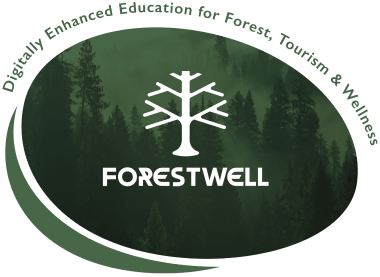Topic Progress..
In this topic, you will learn how Storytelling can be a powerful tool for ForestWell to convey its mission, values and the transformative experiences it offers in forested environments. Through compelling narratives, ForestWell can inspire, educate, and engage its audience while fostering a deep emotional connection with nature and well-being. Here’s how ForestWell can leverage storytelling.
We introduce the versatile possibilities of storytelling, first from the point of view of different storytellers and then from the point of view of the goal and content.
What if trees spoke the language we understand?
David George Haskell is a Pulitzer-nominated author who published the book called ‘The Song of Trees’. He asks us to pay attention to how to create stories to help people as well as forests heal.
You can hear author´s thoughts in the video below:
When thinking about a typical Icelandic landscape, trees and forests are probably not the first thing that comes to mind, and there aren’t any big forests there. Watch the video here and think about how it could be used as inspiration for a story
When using local and especially indigenous stories, it is important to check their accuracy so that they do not offend in any way or suggest that the storyteller appropriates the story in her/his name. Collect content by talking to local people and inviting them to help produce the service. Tell the participants about your own experiences and your connection to the place where you work. Perhaps you are a local and can share your own story about the place.
Finland has ranked to be the number one in the UN´s Happiness report for seven years in a row (2024). It takes into account factors such as healthy life expectancy, freedom to make life choices, gross domestic product (GDP), generosity, social support from friends, perceived corruption, as well as recent emotions of the respondents, both good and bad.
In 2020, the French editor of Le Monde magazine wanted to experience how connection with nature is linked to happiness. She was taken to the forest to do small forest healing exercises, hug trees and eat snacks by the open fire. The picture below ended up on the magazine’s pages. If you want, you can read more about the visit and nature-based happiness in the linked article: Nature-based Happiness.
There are different forms of Forest Therapy in different parts of the world. The nature of the place makes every forest therapy unique and is the source of Storytelling. Glengarriff Forest Therapy provides forest bathing walks and forest therapy Retreats amongst the Magnificent ancient oak forest in Glengarriff Nature Reserve, West Cork Ireland.
Notice the forest therapist’s relationship with nature through this text and visit then the company´s Case Study material
The forest therapist works in partnership with the forest to create the best conditions for growth and healing, making every walk unique. The forest is the real therapist and the guide simply opens the doors. Glengariff Forest Therapy, Ireland
ForestWell storytelling should be authentic, emotionally resonant, and aligned with the initiative’s values. By weaving these stories into its communication efforts, ForestWell can create a narrative that not only attracts participants but also fosters a deep connection with the mission of well-being and nature immersion in forested environments.
